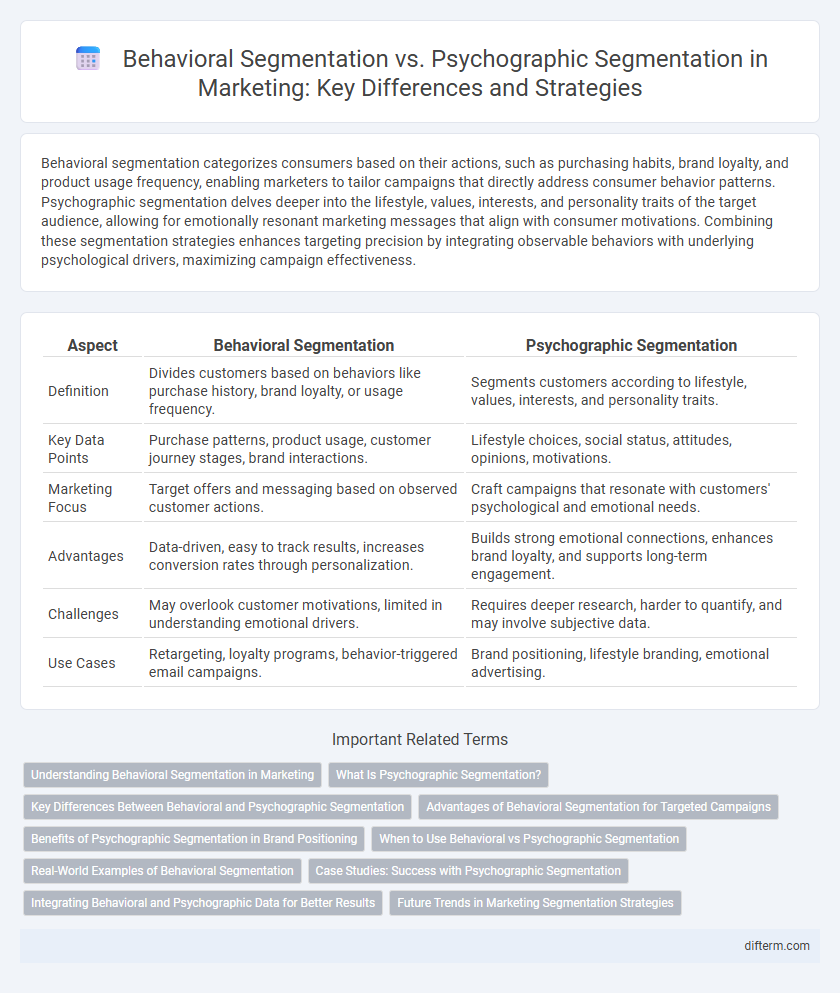Behavioral segmentation categorizes consumers based on their actions, such as purchasing habits, brand loyalty, and product usage frequency, enabling marketers to tailor campaigns that directly address consumer behavior patterns. Psychographic segmentation delves deeper into the lifestyle, values, interests, and personality traits of the target audience, allowing for emotionally resonant marketing messages that align with consumer motivations. Combining these segmentation strategies enhances targeting precision by integrating observable behaviors with underlying psychological drivers, maximizing campaign effectiveness.
Table of Comparison
| Aspect | Behavioral Segmentation | Psychographic Segmentation |
|---|---|---|
| Definition | Divides customers based on behaviors like purchase history, brand loyalty, or usage frequency. | Segments customers according to lifestyle, values, interests, and personality traits. |
| Key Data Points | Purchase patterns, product usage, customer journey stages, brand interactions. | Lifestyle choices, social status, attitudes, opinions, motivations. |
| Marketing Focus | Target offers and messaging based on observed customer actions. | Craft campaigns that resonate with customers' psychological and emotional needs. |
| Advantages | Data-driven, easy to track results, increases conversion rates through personalization. | Builds strong emotional connections, enhances brand loyalty, and supports long-term engagement. |
| Challenges | May overlook customer motivations, limited in understanding emotional drivers. | Requires deeper research, harder to quantify, and may involve subjective data. |
| Use Cases | Retargeting, loyalty programs, behavior-triggered email campaigns. | Brand positioning, lifestyle branding, emotional advertising. |
Understanding Behavioral Segmentation in Marketing
Behavioral segmentation in marketing categorizes consumers based on their actions, such as purchasing habits, brand loyalty, and product usage frequency. This approach enables marketers to tailor campaigns according to specific behaviors, enhancing customer engagement and conversion rates. Understanding behavioral segmentation helps optimize resource allocation by targeting audiences most likely to respond to marketing efforts.
What Is Psychographic Segmentation?
Psychographic segmentation categorizes consumers based on their lifestyles, values, interests, and personality traits, providing deeper insights into motivational factors behind purchasing decisions. This approach helps marketers tailor messages that resonate emotionally, improving engagement and brand loyalty. Unlike behavioral segmentation, which tracks actions and usage patterns, psychographic segmentation delves into psychological attributes to predict future behavior and preferences.
Key Differences Between Behavioral and Psychographic Segmentation
Behavioral segmentation categorizes consumers based on their actions such as purchasing patterns, brand interactions, and product usage frequency, while psychographic segmentation analyzes consumers' lifestyles, values, interests, and personality traits. Behavioral data provides concrete insights into when and how customers engage with products, whereas psychographic data reveals motivational drivers behind consumer choices. Understanding these key differences enables marketers to tailor strategies that address both the observable behaviors and underlying attitudes of target audiences for more effective campaigns.
Advantages of Behavioral Segmentation for Targeted Campaigns
Behavioral segmentation allows marketers to target audiences based on actual consumer actions such as purchase history, brand loyalty, and usage frequency, resulting in highly personalized campaigns that improve conversion rates. This approach enhances ad relevance by aligning offers with specific consumer needs and experiences, increasing engagement and return on investment. By leveraging real-time behavioral data, businesses can quickly adapt marketing strategies to evolving customer preferences, ensuring timely and effective communication.
Benefits of Psychographic Segmentation in Brand Positioning
Psychographic segmentation enhances brand positioning by aligning products with customers' lifestyles, values, and personality traits, resulting in deeper emotional connections and stronger brand loyalty. It enables marketers to create tailored messages that resonate with specific consumer motivations, driving higher engagement and conversion rates. Unlike behavioral segmentation, psychographic insights offer nuanced understanding of consumer attitudes, fostering more impactful and distinctive brand experiences.
When to Use Behavioral vs Psychographic Segmentation
Behavioral segmentation is ideal when businesses need to analyze customer actions such as purchase history, usage frequency, or brand loyalty to tailor marketing strategies effectively. Psychographic segmentation suits scenarios requiring deep insights into customer lifestyles, values, attitudes, or personality traits for creating emotionally resonant campaigns. Combining both methods enhances targeting precision, improving consumer engagement and campaign ROI in complex markets.
Real-World Examples of Behavioral Segmentation
Behavioral segmentation divides consumers based on actions such as purchase history, product usage, and brand loyalty, enabling companies like Amazon to tailor recommendations that boost conversions. For example, Netflix analyzes viewing patterns to personalize content suggestions, enhancing user engagement and retention. This data-driven strategy contrasts with psychographic segmentation, which clusters audiences by lifestyle and values, by emphasizing observable behaviors for targeted marketing campaigns.
Case Studies: Success with Psychographic Segmentation
Case studies reveal that psychographic segmentation excels in creating personalized marketing campaigns by targeting consumers' lifestyles, values, and personalities, leading to higher engagement and conversion rates compared to behavioral segmentation, which relies solely on past actions. For example, brands like Nike and Spotify leverage psychographic data to tailor messages that resonate emotionally, resulting in increased brand loyalty and customer retention. This approach allows marketers to tap into deeper motivations, driving more effective communication and optimized marketing ROI.
Integrating Behavioral and Psychographic Data for Better Results
Integrating behavioral and psychographic segmentation enhances marketing precision by combining customer actions like purchase history and browsing behavior with psychological factors such as values, lifestyle, and personality traits. This dual approach enables brands to tailor personalized campaigns that resonate deeply, driving higher engagement and conversion rates. Utilizing advanced analytics platforms to merge these datasets uncovers nuanced customer insights, allowing marketers to optimize targeting strategies and achieve improved ROI.
Future Trends in Marketing Segmentation Strategies
Behavioral segmentation leverages consumer actions such as purchase history and brand interactions, while psychographic segmentation delves into lifestyles, values, and personality traits to predict future buying behaviors. Emerging trends emphasize integrating AI-driven analytics and big data to create dynamic, real-time segments that combine both behavioral and psychographic insights for hyper-personalized marketing. Marketers are increasingly adopting predictive modeling and sentiment analysis to anticipate evolving consumer needs and enhance customer engagement.
Behavioral segmentation vs psychographic segmentation Infographic

 difterm.com
difterm.com